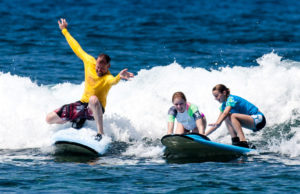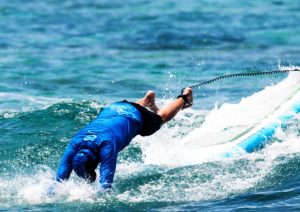How to Correctly Wipeout When Surfing
In surfing, the wipeout is the easiest maneuver to master. Knowing how to correctly wipeout when surfing is an important skill for all surfers to learn.
Almost all of the bad things that can happen when surfing do so during a wipeout. Some of the worst things that can happen include broken boards, injuries, collisions with other surfers and drowning. Luckily, learning how to correctly wipeout when surfing can decrease the likelihood of any of these things happening.
Learn how to prevent a wipeout from ever happening.
By staying within your comfort zone, you can avoid putting yourself in a position where a bad wipeout can happen.
Check out the conditions before getting in the water. Its always good to watch the surf for at least 15 minutes. It may look small but when a set rolls in it can be much bigger than you are able to handle. Don’t paddle out in waves that are too big for your skill level. This is a recipe for disaster. The bigger the waves are the harder and more violent the wipeout will be.
Check for exposed rocks or reef as well. A wipeout surfing near rocks is always much more dangerous. If you have never paddled out at a spot before, check with local lifeguards for info on any dangerous areas.
Results of a Wipeout when Surfing
Dings and Broken Surfboards –If your surfboard hits the bottom, a rock or another surfer during a wipeout, it could put a nice ding in your surfboard or worse break it completely.
Cuts –Just like your surfboard, if you hit the bottom, a rock or another surfer during a wipeout, you could get cut up by the reef or the fins of the surfboard which are really sharp.
Broken Neck– If you wipeout and fall head first into the water you could break your neck, especially if you are surfing in a shallow and rocky area.
Hitting other Surfers– If there are other surfers around you, their bodies and boards can become dangerous obstacles. Wiping out near other surfers can cause dings and cuts to both surfers. Plus you might make the other surfer angry if you damage their surfboard. Learning proper surf etiquette will also help you avoid this situation.
Drowning– This is a very rare occurrence in surfing but it does happen. If you hit the bottom and get knocked unconscious, you could drown. It is always a good idea to use the buddy system when surfing that way you can watch out for each other.
How to wipe out properly.
Fall away from your surfboard– If you feel like you are going to wipe out try to fall as far away from your surfboard as possible. You don’t want to hit your board on the way down and you don’t want the surfboard to come back and hit you in the head. You can extend your arms to help keep the surfboard away from your body.
Don’t dive head first– Just like in the shallow end of a pool, there is no diving head first when wiping out. This is a sure fire way to hit the bottom and break your neck. The easiest and safest way to wipe out is by landing on your butt and extending your arms out so they slap the surface of the water. This is called a shallow fall which will decrease your chances of hitting the bottom.
Don’t jump feet first– This may seem like a good idea but if you land in shallow water your could sprain your ankle or cut your feet up if you are surfing over reef.
Don’t panic– The best thing you can do when you wipe out is not to panic. This gets your heart pumping and makes your body use up more oxygen. Don’t worry though because unless you are surfing really big waves, you probably won’t be held under water for more than 10 seconds.
Cover your head when you come out of the water– When you wipeout your surfboard could go fling in the air and come down on your head or a wave could push the surfboard into you. Make sure that you use your arms to cover your head and face when you come up from a wipe out.
Relax and Recover– If you had a really bad wipe out, get back on your board and paddle to an area where you can rest for a moment and catch your breath.
The wipeout is a part of surfing, whether you like it or not. Luckily, the better you get the less you will wipeout. Beginner surfers will spend most of their time falling off of their surfboards rather than riding them so it is very important to be cautious of your surroundings and wipeout safely.










When wiping out one thing I pay attention to that has saved me a good bit of times is the leash tension. When you wipe out pay attention to whether or not you feel the leash pulling your leg forward.
If you feel the leash pulling your leg forward, the board is in front of you and it’s safe to come up. If you don’t feel the leash tugging at your leg it means the board is behind you and when you come up it may slam you in the head. In this case I always swim forward until I feel the leash tighten.
It’s a little tricky to pay attention to your lease when your getting washing machined by some rolling white water. But if you make habit of mentally paying attention to it, eventually it will come naturally. There’s nothing worse than taking a knocking to the ole noggin by your own board.
Best advice so far.
Should have read this before last Sunday. 7 years old post and still missed it 🙂
That’s a good point that you wouldn’t want to hit your head on the boar on the way down. I would think that would be bad if you knocked yourself out and then fell in the water. I’ll have to make sure that I fall away from the board if I wipe out while learning to surf.
https://www.pacificsurf.com/service/surf-lesson/